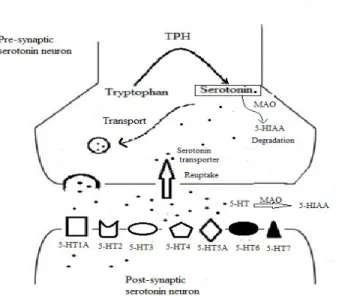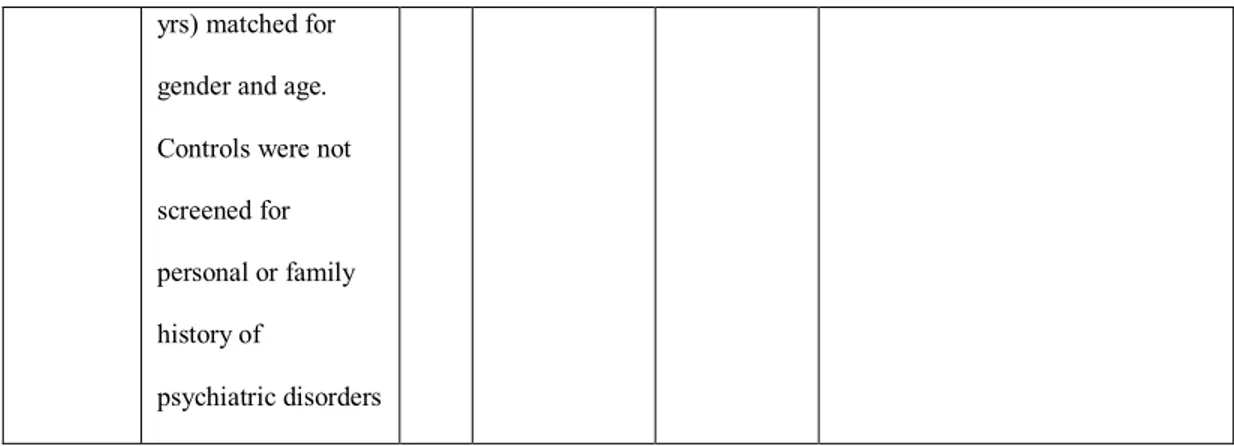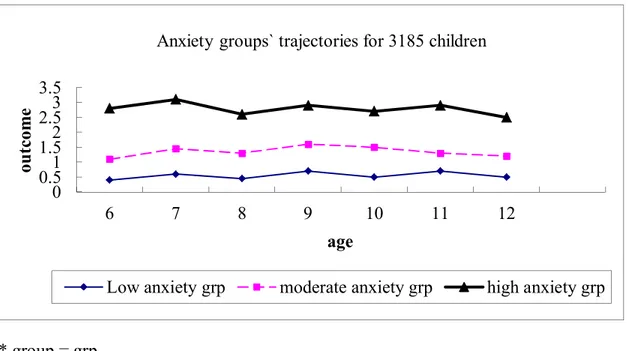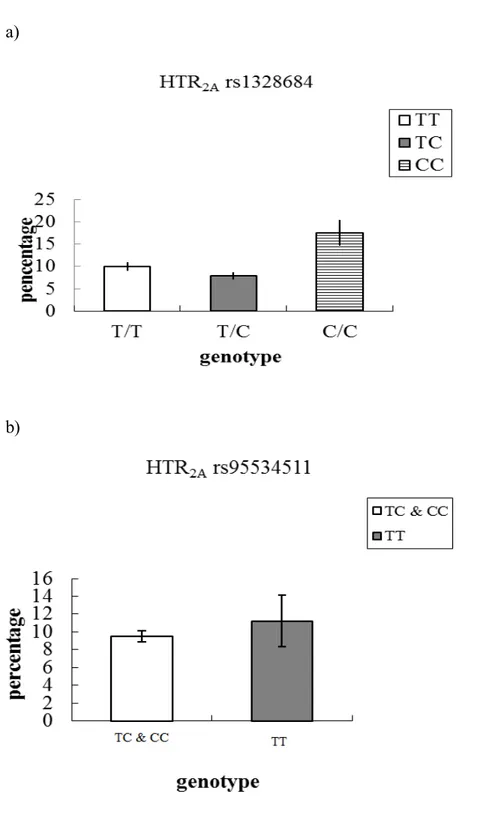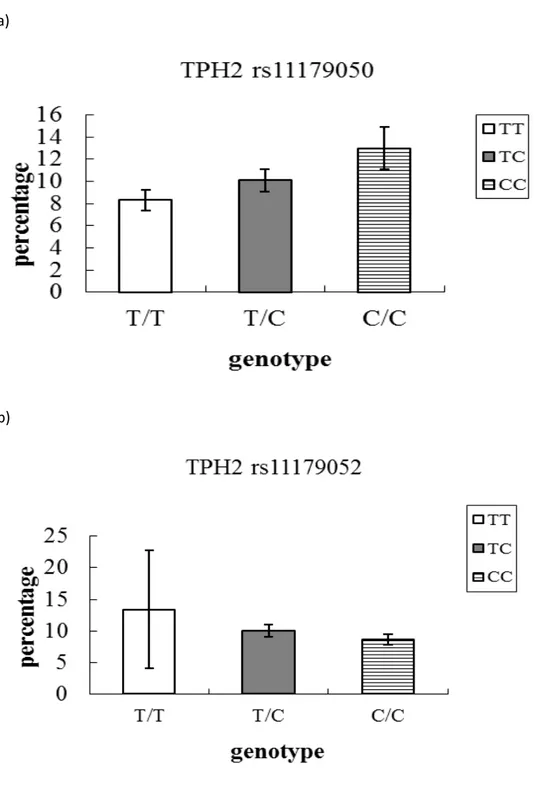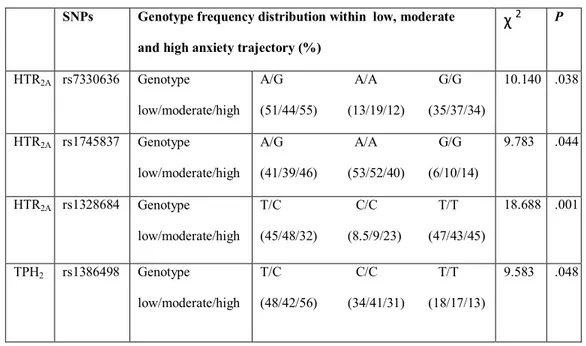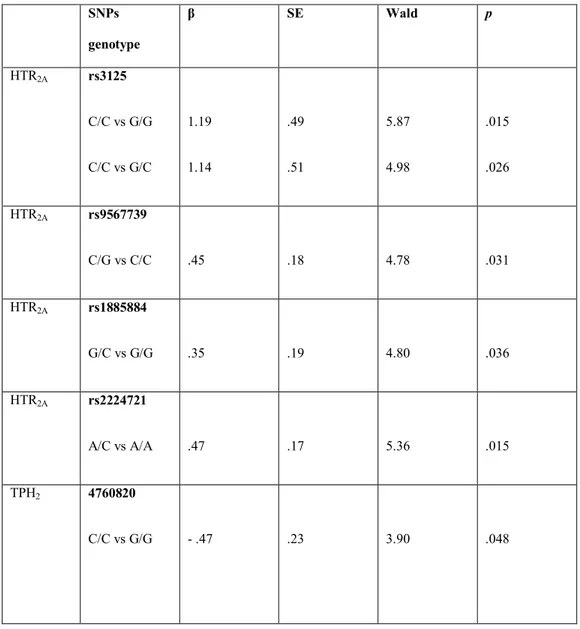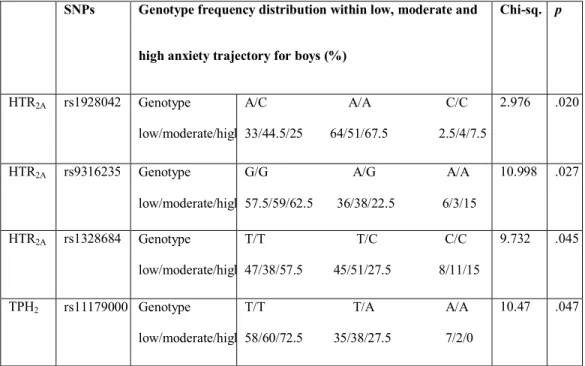Université de Montréal
Le rôle de la sérotonine sur le développement de traits anxieux: une étude
de trajectoire longitudinale
par
Tina Farshadgohar
Département de Sciences Biomédicales Option Psychiatrie
Faculté de médecine
Mémoire présenté à la Faculté des études supérieures
en vue de l’obtention du grade de
Maître ès sciences (M. Sc.)
en Sciences biomédicales
Option Sciences Psychiatriques
Février, 2012
Université de Montréal
Faculté des études supérieures
Ce mémoire intitulé :
Le rôle de la sérotonine sur le développement de traits anxieux: une étude
de trajectoire longitudinale
présenté par :
Tina Farshadgohar
évalué par un jury composé des personnes suivantes : Graciela Piñeyro, Ph.D. président-rapporteur Linda Booij, Ph.D. directeur de recherche Jean R. Séguin, Ph.D. co-directeur Adrianna Mendrek, Ph.D. examinateur externe
Résumé
Certains gènes, modulant la sérotonine (5-hydroxytryptamine, 5-HT), ont été
associés aux tempéraments liés à l'anxiété. Une limitation dans la plupart de ces
études est que les études sont de nature transversale et l'anxiété a été évaluée à un
seul point dans le temps. De plus, seules quelques études ont été réalisées chez les
enfants. Le but de la présente étude était d'étudier le rôle des gènes HTR2A et
TPH2 dans le développement des trajectoires d’anxiété durant l’enfance. Les
associations entre ces gènes, ces trajectoires, le diagnostic d’anxiété à l'âge adulte
et les différences entre les sexes ont été examinées dans l'Étude Longitudinale des
Enfants de Maternelle au Québec, composée de 3185 enfants recrutés en
1986-1987. Leur anxiété a été cotée par leur professeur annuellement entre 6 et 12 ans.
Ces cotes ont été modélisées en trajectoires comportementales. Les données
genotypées de 5-HT, disponibles pour 1068 personnes, ont été analysées en
utilisant les statistiques du Chi-carré, des régressions logistiques et des analyses
de variance. Sur les 37 polymorphismes étudiés, plusieurs ont été associés à la
trajectoire de forte anxiété, tels le 5-HTR2A (rs1328684, rs95534511, rs1745837,
rs7984966, 7330636) et TPH2 (rs11179050, rs11179052, rs1386498). Bien que les
trajectoires d’anxiété en enfance n’aient pas prédit le diagnostic d'anxiété à 21
ans, les relations ont été trouvées entre ce diagnostic, HTR2A et les
polymorphismes du nucléotide simple (PNS) de TPH2. On remarque que les PNS
associés à l’anxiété durant l’enfance et l’âge adulte ne sont pas les mêmes. La
force d'association entre les gènes étudiés et l'anxiété diffère entre les garçons et
TPH2, 5-HTR2A et les trajectoires d’anxiété en enfance. Les études futures
devraient reproduire les résultats dans d'autres échantillons, enquêter sur
l'interaction avec les facteurs de stress, et étudier la pertinence fonctionnelle de la
PNS.
SUMMARY
A number of genes known to modulate serotonin (5-hydroxytryptamine, 5-HT)
have been associated with anxiety-related temperaments. A limitation in most of
these studies is that the studies are cross-sectional and anxiety has been measured
at a single point in time. Furthermore, only a few studies have been done in
children. The aim of the present study was to investigate the role of the HTR2A
and TPH2 gene in the development of trajectories of anxiety in childhood/
adolescence. Associations between these genes, anxiety trajectories in childhood
and anxiety diagnoses in adulthood were also investigated. Finally, gender
differences were explored. Research questions were investigated in the Quebec
Longitudinal Study of Kindergarten Children, consisting of 3185 boys and girls,
selected in 1986-1987. Children`s anxiety was rated by their teacher every year
between the age of 6 and 12 years. The ratings were modeled into behavioral
trajectories. 5-HT genotyping data were available for 1068 cohort members. Data
were analyzed using Chi-square statistics, logistic regressions and ANOVAs. Out
of 37 investigated polymorphisms, several polymorphisms, such as 5-HTR2A
(rs1328684, rs95534511, rs1745837, rs7984966, 7330636) and TPH2
(rs11179050, rs11179052, rs1386498) were associated with a high anxiety
trajectory. Though trajectories of high anxiety in childhood did not predict an
anxiety diagnosis at age 21, relationships were found between HTR2A and TPH2
SNPs and anxiety diagnosis at age 21. We note that the SNPs associated with
anxiety were different between adults and children. The strength of association
is the first study reporting an association with some HTR2A and TPH2 variants and
trajectories of anxiety in children. Future studies should replicate the findings in
other samples, investigate the interaction with stressors, and study the functional
relevance of the SNPs.
Table of contents
JURY IDENTIFICATION PAGE II
RÉSUMÉ EN FRANÇAIS III
SUMMARY V
TABLE OF CONTENTS VII
LIST OF TABLES X
LIST OF FIGURES XI
LIST OF ABBREVIATIONS XII
DEDICATION XIII
ACKNOWLEDGEMENTS XIV
INTRODUCTION 15
1. Anxiety 16
1.1 Anxiety trait versus anxiety disorders 16
1.2 Epidemiology of anxiety 17
1.2.1 General Anxiety Disorders 17
1.2.2 Panic Disorder 18
1.3 Heritability of anxiety disorders 19
1.4 Development of Anxiety; role of childhood factors 20
1.5 Neuroanatomy of anxiety 21
1.5.1 Hippocampus 22
1.5.3 Limbic cortex 23
1.6 Neurotransmitters mediating anxiety 23
1.6.1 Gamma-amino butyric acid 24
1.6.2 Noradrenalin 25
2. Serotonin 25
2.1 The serotonergic system 26
2.1.1 The anatomy of the serotonergic system 26
2.1.2 Serotonin synthesis and turnover 27
2.1.3 Serotonin receptors 29
2.1.4 The serotonin transporter 31
2.1.5 Serotonin and behavior 32
2.2 HTR2A and anxiety 33
2.3 TPH2 and anxiety 34
3. Anxiety, Serotonin and Sex 46
4. Summary 47
OBJECTIVE 49
METHOD 50
Study sample 51
Developmental trajectories of anxiety 51
Diagnostic Interview Schedule for Adults (DIS) 53
Genotyping 53
Statistics 54
Continuous approach 54
RESULTS 57
Relationship between 5-HT genes and anxiety trajectories 58
Continuous approach 58
Effects of genotype on probability of high anxiety 58
Categorical approach 62
Effect of genotype on anxiety trajectory classification 62
Anxiety trajectories and clinical diagnosis in adulthood 65
Gender differences 67
Effect of genotype on anxiety trajectory classification 67 Additive effect of gender on genotype and anxiety trajectories 69
DISCUSSION 70
List of tables
Table-1: Summary of different subtypes of receptors with its distributions and
effector mechanisms.
Table 2-1: Summary of studies investigating the link between anxiety disorders
(social and specific phobia, OCD, GAD, SAD, PD) and TPH2 polymorphisms.
Table 2-2: Summary of studies investigating the link between panic disorder and
TPH2 polymorphisms.
Table 2-3: Summary of studies investigating the link between OCD and TPH2
polymorphisms.
Table 3: Distribution of genotype frequencies of HTR2A and TPH2
polymorphisms as a function of anxiety trajectory.
Table 4: Results of the logistic regression analyses, predicting anxiety diagnosis
in adulthood from HTR2A and TPH2 genotypes.
Table 5: Distribution of genotype frequencies of the HTR2A and TPH2
polymorphisms within low, moderate and high anxiety trajectories in boys
(percentage of genotype frequency), p < .05.
Table 6: Distribution of genotype frequencies of the HTR2A and TPH2
polymorphisms within low, moderate and high anxiety trajectories in girls
List of figures
Figure 1: Biosynthesis of 5-HT.
Figure 2: Schematic illustration of serotonergic synapse. After tryptophan is
converted to 5-HT, 5-HT is packaged into storage vesicles or passes through a
membrane by the 5-HT transporter (SERT). Then 5-HT stimulates its post
synaptic receptors.
Figure 3: Schematic illustration of the 5-HT transporter. First, sodium binds to
5-HT and both of them bind to the transporter followed by a chloride ion. Then,
neurotransmitters and ions release into the cytoplasm of the neuron. The
reorientation of the carrier is occurring by binding intracellular potassium into the
transporter and releasing potassium outside the cell.
Figure 4: Development trajectories of anxiety, between age of 6 and 12 years.
Figure 5-1: Probability to be in the high anxiety trajectory, as a function of 5-HT2A
genotype rs1328684 (a) and rs95534511 (b). Probabilities are expressed in
percentages.
Figure 5-2: Probability to be in the high anxiety trajectory, as a function of TPH2
genotype rs11179050 (a) and rs11179052 (b). Probabilities are expressed in
List of abbreviations
5-HT: 5-hydroxytryptamine, serotonin
AADC: aromatic L-amino acid decarboxylase
DIS: Diagnostic Interview Schedule
DRN: dorsal raphe nuclei
ELEMQ: Étude Longitudinal des Enfants de Maternelle au Québec
GABA: gamma-aminobutyric acid
GAD: general anxiety disorders
HTR2A: hydroxytryptamine receptor 2a
LD: linkage disequilibrium
MRI: magnetic resonance imaging
OCD: obsessive-compulsive disorder
PD: panic disorder
PET: positron emission tomography
PTSD: post-traumatic stress disorder
SAD: social anxiety disorder
SNP: single-nucleotide polymorphism
SSRI: selective serotonin reuptake inhibitor
To the bright memory of my husband
Acknowledgements
I would like to dedicate my thesis in memory of my beloved husband Mehdi, who passed away before my final submission, his love and lifelong support has enabled
me to achieve my goals and finish what I have started.
It would not have been possible to write this master thesis without the help and
support of the kind people around me, to only some of whom it is possible to give
particular mention here.
I would like to express my appreciation to my primary supervisor Dr. Linda
Booij, for giving me the opportunity to be part of her laboratory group. This thesis
would not have been possible without her help, support and patience. Also special
thanks to my co-supervisor Dr. Jean R. Séguin, Dr. Graciela Piñeyro (president of
the thesis committee) and Dr. Adrianna Mendrek (external examiner) for their
time and patience. It has been an honor to work with all of you.
The most special thanks go to my parents for giving me your unconditional
support and love through all this long process to complete my thesis.
1. Anxiety
1.1 Anxiety trait versus anxiety disorders
Anxiety and fear are human emotions that have a protective role in order
to avoid situations which cause injury, pain or even death (Moffitt, 2005; Rex,
2010). Although anxiety is a biologically normal and adaptive condition, it could
be pathological and interfere with the capability to successfully manage numerous
challenges and/or stressful events, and even alter the body condition (Steimer,
2002). Acute or immediate levels of anxiety could be defined as state anxiety;
whereas trait anxiety is a long-term anxiety response predisposition to events
(Perez-Edgar & Fox, 2005). Certain personality traits, especially high levels of
neuroticism (a tendency to experience negative emotions, thereby having a greater
chance of feeling anxious, sad and angry in normal situations) is an important risk
factor for the development of an anxiety disorder (Hettema, Neale, Myers,
Prescott, & Kendler, 2006).
The development of human anxiety disorders is based on three interacting
sets of vulnerability factors: 1) a generalized psychological vulnerability: largely
resulting from early life experiences 2) a specific psychological vulnerability:
mainly focused on specific events or situations and 3) a generalized biological
vulnerability: based on genetic origins (Barlow, Grenyer, & Ilkiw-Lavalle, 2000;
Steimer, 2002).
According to the Diagnostic and Statistical Manual of Mental Disorders
(fourth edition, test revision) (DSM-IV-TR) anxiety disorders are divided into
(PD), specific and social phobias, obsessive-compulsive disorders (OCD) and
post-traumatic stress disorder (PTSD) (American Psychiatric & American
Psychiatric Association. Task Force on, 2000).
Anxiety-related behaviors seem to be controlled by the distribution and
interconnection of neural circuits in the brain (Lowry & Hale, 2010). A variety of
neuroendocrine, neurotransmitter and neuroanatomical alterations could occur in
anxiety disorders (Martin, Ressler, Binder, & Nemeroff, 2009). In the following
sections of my thesis, the neural and anatomical systems involved in modulating
anxiety will be briefly discussed.
1.2 Epidemiology of anxiety
Anxiety disorders are among the most prevalent psychiatric disorders with
an approximate lifetime prevalence of 28.8% and an approximate 12-month
prevalence of 18.1% in the general population (Kessler, Berglund, et al., 2005;
Kessler, Chiu, Demler, Merikangas, & Walters, 2005). Epidemiological studies
demonstrated that females are more likely to develop PD (7.7%) and GAD (6.6%)
than men (2.9% and 3.6 %, respectively). The prevalence of PTSD is also higher
in females than in males (12.5% vs. 6.2%)(Kessler et al.,1994). This thesis
focuses on GAD and PD.
1.2.1 General Anxiety Disorders
According to the national comorbidity survey (NCS) in United States, the
lifetime prevalence of GAD is approximately 5.7 % (Kessler, Berglund, et al.,
2005). According to the DSM-IV-TR (American Psychiatric & American
anxiety and worry, occurring more days than not for a period at least 6 months,
about a number of events or activities and the person usually finds it difficult to
control the worry (American Psychiatric & American Psychiatric Association.
Task Force on, 2000). There are six symptoms for GAD: restlessness, being easily
fatigued, irritability, muscle tension, difficulty concentrating and sleep
disturbance (American Psychiatric & American Psychiatric Association. Task
Force on, 2000). In order to meet the formal diagnostic criteria, at least three of
these symptoms need to be present and they must affect social or occupational
functioning. Most of the people with GAD report that they have felt anxious and
nervous all their life (American Psychiatric & American Psychiatric Association.
Task Force on, 2000). More than half of individuals presenting for treatment
report onset in childhood and onset in adulthood (American Psychiatric &
American Psychiatric Association. Task Force on, 2000). GAD has a chronic but
fluctuating course and often worsens during periods of stress (American
Psychiatric & American Psychiatric Association. Task Force on, 2000).
1.2.2 Panic Disorder
The lifetime prevalence of PD is estimated to be 4.7% in the United States
(Kessler, Chiu, et al., 2005). According to the DSM-IV-TR, one-year prevalence
rates are approximately 1% and 2 % (American Psychiatric & American
Psychiatric Association. Task Force on, 2000). PD implicates recurrent,
unexpected panic attacks followed by at least one month of persistent concern
about having another panic attack, worry about the consequences of the panic
Psychiatric & American Psychiatric Association. Task Force on, 2000). The
symptomology associated with this disorder includes shortness of breath, feeling
of choking, palpitation, sweating, trembling or shaking, a feeling of losing control
or going crazy and fear of dying. PD is associated with the discrete period of
intense fear in the absence of real danger and having at least four of these
symptoms (American Psychiatric & American Psychiatric Association. Task
Force on, 2000).The age of onset lies between late teenage years and the mid-30s,
with the first peak in late adolescence and a second smaller peak in the mid-30s.
However, the age of onset could differ considerably, from the beginning of
childhood until after age 45 (American Psychiatric & American Psychiatric
Association. Task Force on, 2000).
1.3 Heritability of anxiety disorders
Anxiety disorders have been shown to be heritable. Family studies
compare the phenotype prevalence among affected members of family with
unaffected members (Na, Kang, Lee, & Yu, 2011). Several family studies have
demonstrated an increasing risk for PD (5.7%-17.3%) between affected
individuals’ relatives and unaffected relatives (Goldstein et al., 1994; Horwath et
al., 1995; Maier, Lichtermann, Minges, Oehrlein, & Franke, 1993; Noyes et al.,
1986). A meta-analysis confirmed a heritability across GAD, OCD, PD and
phobias in a moderate range (30%-40%) (Hettema, Neale, & Kendler, 2001).
Moreover, in a large population-based female adult twins sample, comparing
monozygotic with dizygotic twins, Kendler et al. estimated the heritability at
phobia, situational phobia and simple phobia) (Kendler, Neale, Kessler, Heath, &
Eaves, 1992, 1993). These results were confirmed in a later study, showing
similar estimations of hereditability for men in GAD and PD (Scherrer et al.,
2000). A recent adult twin-study analysis, consisting of more than 5,000 twins,
estimated a heritability of 28% for PD (Hettema, Prescott, Myers, Neale, &
Kendler, 2005).
Finally, a high familial and genetic connection has been demonstrated for
anxiety-related personality traits (Smoller et al., 2001; Weissman et al., 2000).
Thus, genetic factors clearly contribute to the pathogenesis of anxiety disorders.
1.4 Development of Anxiety; role of childhood factors
Longitudinal epidemiological studies have shown that high and persisting
levels of anxiety or depressive disorders in childhood or early adolescence are
strong predictors of anxiety diagnosis in adulthood (Beesdo, Knappe, & Pine,
2009; Bittner et al., 2007; Pine, Cohen, Gurley, Brook, & Ma, 1998). For
instance, in an epidemiological study, Pine et al. selected a sample of 776 young
people who received DSM-based psychiatric assessment between1983-1992.
They showed that an anxiety disorder during adolescence predicted recurrent
anxiety disordersin early adulthood (Pine et al., 1998).
While anxiety in childhood could predict anxiety disorders in adulthood,
other longitudinal studies have shown that a lack of anxiety (fearlessness) could
be a predictor of aggressive problems later in life. Specifically, fearlessness at age
3 was associated with aggression problems at age 11 (Raine, Reynolds, Venables,
later became criminals showed significantly reduced fear conditioning in
adulthood (Gao, Raine, Venables, Dawson, & Mednick, 2010). An animal study
investigated underlying genetic mechanisms of a lack of fear. By globally
disrupting the function of the HTR2a receptor Weisstaub et al. demonstrated an
association between fearlessness behaviors and 5-HTR2A polymorphisms in mice
(for a description of this gene in greater detail- see page 33) (Weisstaub et al.,
2006). No other animal studies or any human studies investigated the genetic
underpinnings of fearlessness and especially not in the context as predictor of
future problems, such as aggression, and thus the relevance for humans is not
known. However, the above mentioned studies suggest the importance of
measuring both high and low anxiety at an early age and to identify genetic
mechanisms, since both sides of the spectrum may predict future maladaptive
outcome.
1.5 Neuroanatomy of anxiety
Anxiety has a complex function which does not depend on specific brain
areas executing a unique function, so the interaction of several brain regions has
been proposed to be responsible for the symptoms (Martin et al., 2009). The
imbalance of activity in the “emotion center” of the brain is thought to be
responsible for the symptoms of anxiety disorders (Martin et al., 2009). The
limbic system and associated paralimbic brain structures are known to be a set of
brain regions related to emotional-processing and involved in the mediation of
fear(Martin et al., 2009). In a mixed sample of anxiety disorder patients
(using PET), it was shown that elements of the paralimbic belt together with right
inferior frontal cortex and subcortical nuclei mediate symptoms across different
anxiety disorders (S.L. Rauch, C.R. Savage, N.M. Alpert, A.J. Fischman, & M.A.
Jenike, 1997). The hippocampus, amygdala, and limbic cortex are the most
important brain regions modulating anxiety.
1.5.1 Hippocampus
The hippocampus has an important role in memory consolidation. The
hippocampus is partly regulated by the hypothalamus-pituitary-adrenal (HPA)
axis, and has an inhibitory control over this system (Martin et al., 2009).
Hippocampal volume and neurogenesis involved in stress and volume changes
were shown to be related to anxiety disorders (Bonne et al., 2008; Gorman &
Docherty, 2010; Villarreal et al., 2002). A meta-analysis revealed a significantly
reduced hippocampal volume (bilateral) in adults diagnosed with PTSD compared
with healthy controls (Kitayama, Vaccarino, Kutner, Weiss, & Bremner, 2005).
1.5.2 The amygdala
The amygdala is formed of multiple subnuclei, where each nucleus has a
separate pattern of afferent and efferent projections (Martin et al., 2009). This
complex structure is involved in the expression of fear and in fear conditioning,
environment-specific defensive behaviors (Etkin, 2010). Also, the amygdala plays
a role in the realization of emotional and fear-related memories (Martin et al.,
2009). Particularly, basolateral complex and the central nucleus are involved in
anxiety (Heimer, Harlan, Alheid, Garcia, & de Olmos, 1997). Using Magnetic
increases in ratio of the left and right regions of amygdala: hippocampal volume
and severity of anxiety (MacMillan et al., 2003). Another MRI study found that
right and total amygdala volumes were significantly larger in participants with
GAD compared to healthy controls (De Bellis et al., 2000).
1.5.3 Limbic cortex
The limbic cortex, which includes the insular cortex and cingulate cortex,
processes internal bodily state and pain-related sensory and affective information,
motivation and mood (Etkin, 2010). Rauch et al. measured relative regional
cerebral blood flow (rCBF) by Positron Emission Tomography (PET) in 23
participants suffering from anxiety disorders (OCD, simple phobia, PTSD) (S. L.
Rauch, C. R. Savage, N. M. Alpert, A. J. Fischman, & M. A. Jenike, 1997). They
showed increased activation in response to disorder relevant emotional stimuli
(relative to neutral stimuli) in different regions of the brain, including the bilateral
insular cortex. In their previous study, they had found bilateral insula activation
for both simple phobia and PTSD (Rauch et al., 1995; Rauch et al., 1996) bilateral
anterior cingulate activation for simple phobia and PTSD and only left anterior
cingulate activation for patients with OCD (Rauch et al., 1994). Thus, these
findings suggest an implication of the limbic cortex in a variety of anxiety
disorders.
1.6 Neurotransmitters mediating anxiety
Neurotransmitters are chemical messengers involved in the transmission
of a nerve impulse from one cell to another. They are formed inside the
neuron, by an exocytosis process these vesicles release their content in the
synapse. The most important neurotransmitter systems that are implicated in
anxiety include the GABAergic system, the noradrenergic system and the
serotonergic system (Rex, 2010).
1.6.1 Gamma-amino butyric acid
Amino butyric acid (GABA) is the most abundant inhibitory
neurotransmitter in the brain (Steimer, 2002) which tends to be deficient in
anxiety disorders. There are 3 GABA receptor subtypes, GABAA, GABAB and
GABAC (Bormann, 2000). The GABAA receptor is known to have a major role in
anxiety, epilepsy, alcoholism and other psychiatric disorders (Smith, 2001).
GABAA receptors contain 5 protein subunits (α1, α2, α3, α4, α6) which their
distribution is heterogeneous within regions of the brain. Receptor subunit
configuration determines the receptor`s sensitivity to different ligands and its
diversity of function (Lydiard, 2003). The GABAA receptor is often the target of
pharmacologic agents, including the neurosteroids and benzodiazepines. The
relevance of the GABA system for anxiety is widely supported by
pharmacological studies, showing that medication that impact GABA receptors
system (i.e. GABA A receptors), such as benzodiazepines, are effective in the
treatment of anxiety (Nemeroff, 2003; Steimer, 2002). Moreover, a number of
studies have demonstrated that, compared to healthy controls, patients with
anxiety disorders (panic disorder, PTSD and GAD) have lower benzodiazepine
binding in various brain regions as assessed by several researches(J. D. Bremner,
et al., 1997). Also other GABAergic agents, have been evaluated for therapeutic
options (Nemeroff, 2003). Hence, GABA system is an important target in the
treatment of anxiety disorders.
1.6.2 Noradrenalin
The neurotransmitter noradrenalin is closely involved in a range of
psychological processes. Consistent with this, alterations in this neurotransmitter
system have been implicated in a range of psychiatric disorders, including
anxiety. Preclinical studies in rats have shown associations between anxiety and
high levels of noradrenalin in several brain regions, including the hypothalamus
and amygdala (Steimer, 2002). Moreover, Bremner et al., showed that,
yohimbine administration (which is an α2-antagonist) that increases brain
noradrenalin release and results in symptoms of PTSD and fear and anxiety in
PTSD patients) was decreased in prefrontal, temporal, orbitofrontal, and parietal
cortex in patients with Vietnam combat-related PTSD, compared to healthy
controls (Bremner et al., 1997). This suggests that yohimbine administration in
normal controls may be associated with lower levels of norepinephrine release in
central brain regions than in patients with PTSD. Thus, noradrenaline appears to
play an important role in the etiology and treatment of anxiety disorders.
2. Serotonin
The neurotransmitter serotonin controls anxiety with different distinct
mechanisms. For instance, the ascending serotonin pathway (originated from
dorsal raphe nuclei-DRN) facilitates conditioned fear, while the
the most widely investigated neurotransmitter in relation to mental disorders.
Moreover, serotoninergic antidepressants, in particular Selective Serotonin
Reuptake Inhibitors (SSRIs), are the most widely prescribed medication for
internalizing disorders, including anxiety disorders. For the purpose of the present
thesis, this neurotransmitter system will be described in greater detail in the next
section.
2.1 The serotonergic system
2.1.1 The anatomy of the serotonergic system
Serotonin (or 5-hydroxitryptamine, 5-HT) is a key neurotransmitter which
is developed and expressed early in humans (Whitaker-Azmitia, 2010). The
location of serotonergic cell bodies in the brain is limited to the raphe nuclei,
caudal to the isthmus, but serotonergic fibers project to most parts of the brain.
Raphe nuclei are located near the midline of the brainstem with its entire
rostro-caudal extension (Hornung, 2003). There are two groups of serotonergic neurons:
superior group (superior brain stem group) and inferior group (inferior brain stem
group). The superior raphe group is mainly divided into caudal linear nucleus,
dorsal raphe nuclei and median raphe nucleus. The caudal linear nucleus is the
most rostral nucleus of the raphe nuclei containing 5-HT-synthesizing neurons,
while the largest population of serotonergic neurons in human is located in the
dorsal raphe (Hornung, 2003). Most of the serotonergic fibers in the superior
group of raphe nuclei project to the forebrain (Tork, 1990). Also, the dorsal raphe
the basal ganglia, cerebral cortex and median raphe nuclei (caudal division),
innervates the amygdala (Jacobs & Azmitia, 1992).
The inferior raphe group is divided into nucleus raphe magnus, nucleus
raphe obscurus, and nucleus raphe pallidus, all of which project to the spinal cord.
In the central nervous system, the inferior parts contain only 15% of the total
5-HT production (Jacobs & Azmitia, 1992).
2.1.2 Serotonin synthesis and turnover
The physiological effects of 5-HT are mediated by a variety of proteins
that regulate its synthesis, release, reuptake and degradation. 5-HT is a biogenic
monoamine transmitter which contains only one ethylamine linked to an aromatic
ring system (Hasegawa & Nakamura, 2010). In serotonergic cells, 5-HT is
derived from tryptophan, an essential amino acid, which is actively transported
into brain (Hasegawa & Nakamura, 2010). 5-HT cannot pass the brain barrier by
itself, but its precursor L-tryptophan can pass by a facilitated diffusion process,
through the competition between free tryptophan and large neutral amino acids
(Buckworth & Dishman, 2002). 5-HT is synthesized by a short metabolic pathway
consisting of two enzymes: 1) tryptophan hydroxylase (TPH) and 2) aromatic-
L-amino acid decarboxylase (AADC) (Hasegawa & Nakamura, 2010). Tryptophan
hydroxylase is a biopterin-dependent monooxygenase (Kaufman, 1962) which is a
rate-limiting step in the pathway (Fitzpatrick, 1999; Grahame-Smith, 1964;
Ruddick et al., 2006). Tryptophan hydroxylase exists in two isoforms: TPH1and
TPH2. The AADC catalyzes the decarboxylation of 5-hydroxy-L-tryptophan,
Minelli, & Turano, 1971) (Figure 1). The synthesis of 5-HT is dependent on the
tryptophan plasma concentration. A tryptophan-free diet causes a decrease in
tryptophan’s level in plasma and brain which in turn leads to a decrease in
concentration of 5-HT (Biggio, Fadda, Fanni, Tagliamonte, & Gessa, 1974; Booij,
Van der Does, & Riedel, 2003). Finally, a decrease in extracellular 5-HT will
have consequences on neural activity (Feenstra & van der Plasse, 2010).
Figure 1: Biosynthesis of 5-HT.
After synthesizing, 5-HT is stored in vesicular pools or is released to the
Figure 2: Schematic illustration of serotonergic synapse. After tryptophan is converted to 5-HT, 5-HT is packaged into storage vesicles or removed from the
synaptic cleft by the by the 5-HT transporter (SERT). Monoamine oxidase (MAO)
converted 5-HT to 5-hydroxyindoleacetic acid (5-HIAA). Inter-synaptic 5-HT
stimulates its post synaptic receptors (5-HT1-7).Figure based on the Handbook of
behavioral neurobiology of 5-HT (Müller & Jacobs, 2009).
2.1.3 Serotonin receptors
5-HT receptors are distributed in the brain and body in many cell types.
There are at least 14 distinct receptors that are classified into seven groups, 5-HT 1-7 that are mediating 5-HT signaling (Figure 2) (Barnes & Sharp, 1999; Hoyer,
Hannon, & Martin, 2002). 5-HT receptors are all coupled G-proteins (guanine
nucleotide-binding protein), except for 5-HT3 receptor which is a ligand-gated ion
Table-1 Summary of different subtypes of 5-HT receptors with their distributions and effectors mechanisms (Siegel et al., 1999).
Receptor Human locus Distribution Effector mechanism
5-HT1A 5q11.2–13 Hippocampus, amygdala, septum,
entorhinal cortex, hypothalamus, raphe nuclei
Inhibition of adenylyl cyclase, opening of K+ channels 5-HT2A 13q14–21 Claustrum, cerebral cortex, olfactory
tubercle, striatum, nucleus accumbens
Stimulation of phosphoinositide -specific phospholipase C, closing of K+ channels
5-HT2B 2q36.3–37.1 ? b Stimulation of phosphoinositide
-specific phospholipase C 5-HT2C Xq24 Choroid plexus, globus pallidus,
cerebral cortex, pallidus,hypothalamus, septum, substantia nigra, spinal cord
Stimulation of phosphoinositide - specific phospholipase C 5-HT3 ? Hippocampus, entorhinal cortex,
amygdala, nucleus accumbens, solitary tract nerve, trigeminal nerve, motor nucleus of the dorsal vagal nerve, area postrema, spinal cord
Ligand-gated cation channel
5-HT4 ? Hippocampus, striatum, olfactory
tubercle, substantia nigra
Stimulation of adenylyl cyclase
5-ht5A 7q36 ? Inhibition of adenylyl cyclase
5-HT5B 2q11–13 ? ?
5-ht6 ? ? Stimulation of adenylyl cyclase
5-HT7 10q23.3–24.3 Cerebral cortex, septum, thalamus,
hypothalamus, amygdala, superior colliculus
a) Lower-case appellations are used in some cases because the functions mediated by these receptors in intact tissue are presently unknown.
b) Question marks mean that presently no studies have examined this, and thus the locus or distribution is unknown
2.1.4 The serotonin transporter
The 5-HT transporter is a monoamine integral membrane protein (known
as the SERT). In the brain, the highest concentration of 5-HT transporter is in the
midbrain, thalamus and basal ganglia, while the lowest concentration is in the
cortex (Frankle et al., 2006; Houle, Ginovart, Hussey, Meyer, & Wilson, 2000).
The function of the 5-HT transporter is to move 5-HT from the synaptic space
back into presynaptic neurons to be re-used again (Figure 2). This protein
regulates serotonergic system and its receptors by modulating extracellular 5-HT
concentration (Murphy, Lerner, Rudnick, & Lesch, 2004). The 5-HT transporters
carry the preponderance of extracellular 5-HT back into the serotonergic neuron.
These transports are dependent on extracellular concentration of Na+/CL – (Figure 3).
Figure 3: Schematic illustration of the HT transporter. First, sodium binds to 5-HT and both of them bind to the transporter followed by a chloride ion. Then,
neurotransmitters and ions release into the cytoplasm of the neuron. The
reorientation of the carrier is occurring by binding intracellular potassium into the
transporter and releasing potassium outside the cell. Figure based on (Cao, Li,
Mager, & Lester, 1998).
2.1.5 Serotonin and behavior
Both animal and human studies have shown that 5-HT plays a significant
role in a wide range of psychiatric disorders such as anxiety, aggression, suicide,
as well as in certain personality traits, such as neuroticism. Fourteen distinct
receptors mediate signalization of 5-HT (Barnes & Sharp, 1999; Bockaert,
Claeysen, Dumuis, & Marin, 2010; Hoyer et al., 2002). Alteration of gene
expression in these proteins in the brain could have important consequences for
5-HT synaptic availability or signaling in different receptors (O'Leary & Cryan,
2010). Thus, these changes in gene expression, in turn influence the serotonergic
system, which may affect behaviors (O'Leary & Cryan, 2010).
In the past decade, numerous studies have tested associations between
5-HT genes and anxiety traits or anxiety disorders. One of the first studies
investigating the link between 5-HT genes and behavior showed an association
between the short variant of the 5-hydroxytryptamine-linked polymorphic region
(5-HTTLPR) and anxiety-related personality traits (neuroticism) (Lesch et al.,
1996). Since that time, numerous 5-HT genes have been associated with anxiety,
identified and investigated in association with behaviors, of particular interest are
5-hydroxytryptamine receptor 2A (HTR2A)and Tryptophan hydroxylase-2 (TPH2)
polymorphisms. That is because HTR2A and TPH2 are molecules strongly
involved in 5-HT regulation that in turn influence the production of 5-HT in the
brain. These genes and their associations with behaviors are described and
investigated in greater detail in this thesis.
2.2 HTR2A and anxiety
The 5-HTR2A gene is located on chromosome 13q14-q21 in humans and
consists of three exons separated by two introns (Chen, Yang, Grimsby, & Shih,
1992). A number of single nucleotide polymorphisms have been characterized in
this gene, including T102C and –1438A/G in the promoter region (Li, Duan, &
He, 2006).
Wesstaub et al. generated mice that were genetically modified with global
disruption of 5HTR2A signaling capacity (htr2a -/- mice). In these mice, anxiety
traits decreased, while after some restoration mainly in layer V of the cortex for
5-HTR2A, the anxiety phenotype has been reversed (Weisstaub et al., 2006). This
study suggests that 5HTR2A plays an important role in the modulation of conflict
anxiety. Also, 5-HTR2A has been shown to be involved in the pathophysiology of
anxiety disorders in dogs; dogs with anxiety disorders had Lower 5-HT2A receptor
binding index in the left and right frontal cortices than normally-behaving dogs
(Vermeire et al., 2009).
In humans, one study demonstrated an association between PD symptom
polymorphic SNPs of the HTR2A gene were associated with clinical diagnosis of
PD and severity of PD (Unschuld et al., 2007).
Another study found an association between the promoter region of HTR2A (1438
G/A, rs6311) and OCD symptomatology (Walitza et al., 2011). Specifically,
within the OCD patient group, the A allele was associated with higher scores on
the Y-BOCS scores and a 2.5 year earlier age of onset. No other human studies
were found that investigated the association between the 5-HT2A gene and
anxiety. With regard to other psychiatric disorders such as schizophrenia,
attention deficit hyperactivity disorder, suicide, eating disorders, and Alzheimer's
disease, the association between the HTR2A gene and disease have been
inconsistent (Norton & Owen, 2005).
2.3 TPH2 and anxiety
Tryptophan hydroxylase (TPH) has two isoforms, TPH1 and TPH2.
Whereas TPH1 is found mainly expressed in the periphery, a second isoform,
TPH2, is exclusively found in the brain (Hasegawa & Nakamura, 2010). The
TPH2 gene is located on chromosome 12q21.1 and consists of 11 exons (Booij et
al., 2011). A study in inbred mice demonstrated lower (50%-70%) 5-HT synthesis
in the frontal cortex and stratum in homozygous carriers of the 1473G mutation
comparing into homozygous mice carriers of the 1473C mutation (Zhang,
Beaulieu, Sotnikova, Gainetdinov, & Caron, 2004). The relevance of this 1473G
mutation for humans was supported by the initial observation of an association
between the human analogue of this mutant and increased prevalence of
prevalence of this human mutant could not be detected in other human
populations (see Booij et al., 2011 for an overview).
The relevance of other TPH2 variants for human brain 5-HT synthesis was
investigated in a recent study. Specifically, Booij et al. (Booij et al., 2011)
investigated the possible role of intronic TPH2 variants for human brain 5-HT
synthesis in the orbitofrontal cortex, using in vivo positron emission tomography
measures of 5-HT synthesis in 70 participants including 54 with no current mental
disorder. They found dose-effect relationships for two variants which have
previously been associated with suicide, demonstrating the relevance of the TPH2
gene variation for 5-HT synthesis in the human brain.
Compared to the 5-HT2A gene, much more studies are available that have
examined the TPH2 gene in relation to mental health, including studies in anxiety
disorder patients. A summary of these studies can be found in table 2 (Ottenhof,
Ruhé, Lévesque, Booij, & TPH2 and psychiatric morbidity, Manuscript
submitted). The TPH2 gene has also been implicated as a candidate in other
neuropsychiatric phenotypes including; suicidal behavior, depression and
attention deficit/hyperactivity disorder (Ottenhof, Ruhé, Lévesque, & Booij,
Table 2-1: Summary of studies investigating the link between anxiety disorders (social and specific phobia, OCD, GAD, SAD, PD) and TPH2 polymorphisms.
First author; year Participants (male/female; mean age) n Measure ments SNP Association Lin; 2009
Han Chinese women (29.8 yrsa) with prepartum, postpartum and persistent depression, social and specific phobia, OCD, or generalized anxiety disorder diagnosed using SADS Controls (women; 29.7 yrs) with no history of depression or anxiety 117 83 Patients (pts) vs controls LDb C2755A rs4570625 rs11178997 rs11178998 rs11179003 rs17110747
Frequency of the AC genotype was higher in pts relative to controls
No sig. differences in genotype distribution in pts. relative to controls
Higher frequency of the rs4570625- rs11178997 - rs11178998-C2755A G-T-A-A haplotype in pts relative controls (though stricter permutation tests did not show significance)
Weak LD between C2755A and C10662T. LD between most of the adjacent markers.
Fur- mark; 2009
Medication-free pts (14/20; 37.6±8.6 yrs) diagnosed with social anxiety disorder (SAD) (25 generalized, 9 non generalized) using SCID. 7 pts had a 34 Pts vs controls fMRI responses to an emotional
face-rs4570625 No sig. differences in allele frequency in pts. relative controls
T allele carrying patients and controls (controls only at the uncorrected level) show a higher left amygdala response than GG homozygotes
comorbid anxiety disorder: specific phobia (n=5), panic disorder and agoraphobia. Exclusion criteria: SAD treatment of social anxiety disorder in 6 months preceding the study, current serious or dominant psychiatric disorder other than SAD, chronic use of prescribed medication, alcohol or drug abuse, pregnancy, menopause, left handedness, previous PET examination and any somatic or neurologic disorder that could be expected to influence the outcome of the study. Healthy controls (9/9; 34.5±9.5 yrs). 18 processing task: - pts vs controls - subgroups of patients and controls with different genotypes
T allele carrying patients show a higher left amygdala response than GG homozygote controls Carrying the T allele was a significant predictor of reactivity in the left amygdala in the whole sample and in SAD patients
Fur- mark; 2008 Medication-free patients (9/16; 35.6±10.7 yrs) diagnosed with SAD (18 generalized, 7 nongeneralized) using SCID. 8 patients had a comorbid anxiety disorder: specific phobia (n=5), generalized anxiety disorder (n=2), panic disorder (n=1) and mild posttraumatic stress disorder (n=1). Exclusion criteria: SAD treatment of social anxiety disorder in 6 months preceding the study, current serious or dominant psychiatric disorder other than SAD, chronic use of prescribed medication, alcohol or drug abuse, pregnancy, menopause, left handedness, previous PET scan during stressful speaking task Responder s vs non-responders Post- vs pretreatme nt
rs4570625 T allele carriers showed a smaller rCBF decrease from pre- to posttreatment (8 weeks) with placebo in the right and left
(puncorr = 0.009) amygdala.
Pre- to posttreatment differences in amygdala rCBF were only significantly reduced in homozygotic G allele patients The rs4570625 SNP was a predictor for clinical placebo response on day 56.
Homozygosity for the G allele was associated with better outcome.
PET examination and any somatic or neurologic disorder that could be expected to influence the outcome of the study.
Gut-knecht; 2007
German patients diagnosed with cluster B (133/183; 35.3±13.0 yrs) or cluster C (39/65; 38.5±12.7 yrs) personality disorder using SCID-II. A subgroup of 166 pts also had anxiety-related comorbidity comprising neurotic, stress-related or somatoform disorders. Inclusion criteria: diagnosis and age=18-60. Exclusion criteria: medical conditions that have significantly changed the previous level of functioning, lifetime diagnosis of psychotic disorders. 73% of the pts also had a DSM-IV axis I diagnosis. German controls (89/247; 22.4±5.3 yrs). 420 336 Pairwise linkage disequilibri um analysis Allele frequency analysis in pts vs HC Personality measures rs4570625 rs11178997
T allele frequency was higher in pts with anxiety-related disorders (n=166) relative controls. T allele frequency was higher in pts with adjustment disorders (n=99) relative controls.
No sig. differences in allele frequency in pts. relative controls
Personality measures were taken with German versions of the NEO-PI-R and the TPQ.
Note. a: yrs = years , b: LD = linkage disequilibrium
Table 2-2: Summary of studies investigating the link between panic disorder and TPH2 polymorphisms. First author; year Participants (male/female; mean age) n Measurements SNP Association Campos; 2010 Caucasian bipolar pts (82/203; 41.9±12.3 yrsa) diagnosed with MINI-PLUS. A subgroup of 45 pts had lifetime PD comorbidity (6/39; yrs). Exclusion criteria: history of alcohol and drug abuse and dependence. 274 241 Bipolar pts with PD comorbidity vs controls Bipolar patients with PD comorbidity vs Bipolar patients without PD comorbidity rs4448731 rs4565946 rs11179000
Higher frequency of the T allele and T/T genotype in BPD pts with PD relative controls and BPD pts with relative without PD Higher frequency of the C allele and CC genotype (p = 0.058; PMT) in BPD pts with PD relative controls and BPD pts with relative without PD
Higher frequency of the T allele in BPD pts with relative without PD Higher frequency of the C allele and CC genotype in BPD pts with
Healthy controls (52.6±18.9 yrs) rs4760820 rs1487275 rs10879357 rs7955501 rs10506645
PD relative controls and BPD pts with relative without PD
Higher frequency of the C allele in BPD pts with PD relative controls and BPD pts with relative without PD
Higher frequency of the A allele (PMT) and AG genotype (p = 0.063; PMT) in BPD pts with PD relative controls.
Higher frequency of the A allele and AG or AA genotype (PMT) in BPD pts with relative without PD No sig differences in allele frequency or genotype in all analyses
Higher frequency of the rs4448731-rs4565946 T-C haplotype in BPD pts with relative without PD
Lower frequency of the rs4448731-rs4565946 C-T haplotype and the rs10506645-rs4760820 C-C haplotype in BPD patients with relative without PD Kim; 2009 Unrelated Korean patients (50/58; 41.8±10.1 yrs) diagnosed with 108 Pts vs controls Pts vs
rs4570625 Higher frequency of the G allele in:
- Pts relative controls
SCID Exclusion criteria: comorbid mood disorders, psychotic disorders or other anxiety disorders. Severity of the patients’ symptoms was assessed with the STAI, PDSS, ASI, API and HAMD. Unrelated matched Korean healthy controls (122/125; 39.4±9.0 yrs) Exclusion criteria: History of personal or family psychiatric disorders or psychotropic medication. 247 controls in gender subgroups Male vs female pts/controls Symptom severity controls
- Male relative female controls No sig. difference in allele frequency in:
- Male patients relative male controls
- Male relative female patients No sig. difference in genotype in pts relative controls
Lower frequency of the TT genotype in pts relative controls (p = 0.055)
Maron; 2007
Estonian patients (49/164; 37.9±12.6 yrs) diagnosed with the MINI. Patients were included with comorbid agoraphobia (58%), major depression (51%), bipolar 213 Pts vs controls Pts vs controls in gender subgroups Pts vs rs1386494 rs1386483
No sig. differences in allele frequency and genotype in pts. relative controls in whole sample Sig. higher frequency of the rs1386494 A allele and the A/G genotype in female PD patients without comorbidity (n=52) relative female controls. (In the
disorder (14%) and other anxiety disorders (4%). Exclusion criteria: Other psychiatric comorbidity. Matched Estonian healthy controls (91/212; 39.3±13.3 yrs). Exclusion criteria: Personal or family history of psychiatric disorders. 303 controls in a subgroup without comorbidity
whole sample PD patients without comorbidity relative controls p = 0.07 for genotype and p= 0.06 for allele analysis)
The rs1386494-rs1386483 C-G haplotype showed a lower frequency (p = 0.07) and the T-A haplotype showed a higher frequency (p = 0.05) in female patients without comorbidity relative female controls.
Mossner; 2006 Unrelated German patients (49/85; 45.7±11.4 yrs) diagnosed with SADS-LA, CIDI and IDCL. Comorbidity with other anxiety disorders or depressive disorder was allowed as long as panic disorder was predominant. Unrelated German controls (45.2±10.2 134 134 Pts vs controls rs4570625 rs4565946
No sig. difference in allele frequency and genotype in pts relative controls
No sig. difference in allele frequency and genotype in agoraphobic pts relative control
yrs) matched for gender and age. Controls were not screened for personal or family history of
psychiatric disorders
Table 2-3: Summary of studies investigating the link between OCD and TPH2
polymorphisms. First author; year Participants (male/female; mean age) n Measurements SNP Association 2011; Rocha Brazilian-Caucasian pts (18-65 yrsa) diagnosed using the MINI-PLUS. Exclusion criteria: major depression, bipolar disorder, substance-related disorder, psychotic disorder, lifetime history of traumatic / vascular brain injury Brazilian-Caucasian 107 214 Pts vs controls rs4448731 rs4565946 rs11179000 rs7955501 rs10506645 rs4760820 rs1487275 rs10879357
No sig. difference in allele frequency or genotype between pts and controls. Higher frequency of the rs448731-rs4565946-rs10506645 T-C-T and the rs4565946-rs7955501-rs10506645 C-A-T haplotypes in pts relative controls
matched controls screened using the MINI-PLUS. Free of psychiatric illness and no family history of Axis I psychiatric disorder. 2005; Mössner 71 German families of children (41/30; 13.29±2.6 yrs) diagnosed using the C-YBOCSc. Comorbid disorders were assessed using DIPSd. All pts had received in-patient treatment at the University of Aachen. Exclusion criteria: lifetime history of psychotic disorder, Tourette’s syndrome, autistic disorder, alcohol dependence, IQ<70 and if obsessive compulsive symptoms occurred only as part of another disorder. 71 TDTb rs4570625 rs4565946 No preferential allele transmission Preferential transmission of the C allele in pts (p = 0.059) Higher transmission frequency of the CC compared to the TT genotype Preferential transmission of the G-C haplotype in pts. The G-T haplotype was
transmitted to pts less frequently.
Note. a: yrs = years, b: TDT = transmission disequilibrium test, c: C-YBOCS = Yale–Brown Obsessive Compulsive Scale d: DIPS = Diagnostisches Interview bei psychischen Sto¨rungen im Kindes- und
Furthermore polymorphisms in the promoter region of the TPH2 gene have
been reported to be associated with personality traits of harm avoidance and
disorders related to emotional dysregulation in healthy samples (Gutknecht et al.,
2007; Reuter, Ott, Vaitl, & Hennig, 2007).
3. Anxiety, Serotonin and Gender
As indicated above, epidemiological findings reveal a gender difference in
anxiety: females are predisposed to experience anxiety more likely than males
(American Psychiatric & American Psychiatric Association. Task Force on, 2000;
Yonkers, Bruce, Dyck, & Keller, 2003). Given the role of 5-HT in anxiety, one of
the explanations accounting for this difference in prevalence may be related to
gender differences in the regulation of 5-HT. For instance, an in vivo Positron
Emission Tomography (PET) study has shown that the rate of 5-HT synthesis in
healthy males is 52% higher than in healthy females (Nishizawa et al., 1997).
Moreover; females show a greater behavioral response to acute tryptophan
depletion procedures (Booij, van der Does, Haffmans, Spinhoven, & McNally,
2005; Booij et al., 2002). These results pointed to the importance of studying
gender differences in the occurrence of anxiety disorders, as a function of 5-HT
4. Summary
Dysregulation of the serotonergic system has been shown to be an
important factor in the pathophysiology of several psychiatric diseases. In the
previous sections we have focused on several researches showing an association
between 5-HT polymorphisms and anxiety disorders. However, as indicated in the
tables above, research is not always consistent. With regard to HTR2A two animal
studies demonstrated a relation between HTR2A and anxiety-related behavior or
anxiety disorders. In the human studies, whereas two studies demonstrated a
relation between HTR2A and anxiety disorders in the clinical samples (Inada et al.,
2003; Maron et al., 2005) two other studies found no association (Fehr et al.,
2001; Rothe et al., 2004). Regarding the TPH2 gene, conflicting results were
found in human studies. While two studies did not show significant associations
between TPH2 and anxiety disorders (Mossner et al., 2006; Staals et al., 2011)
other three studies demonstrated a relation between TPH2 and anxiety disorders
association(Lin, Ko, Chang, Yeh, & Sun, 2009; Maron et al., 2007). A limitation
of these studies however is that the majority of them measure anxiety at a single
point in time, are cross-sectional and most of the studies are in adults. Thus, the
role of 5-HT genes in the longitudinal developmental course of anxiety is not
known. Compared to cross-sectional studies, longitudinal studies have clear
advantages, especially when they are based on representative community sample
followed over a long period of time (from childhood to adulthood) with multiple
measurements over a long period of time. Hence, a strength of the current study
careful investigation of the developmental course in behaviors, over a long period
Objectives
The aim of the present study was to investigate the relationships between
developmental patterns of anxiety in childhood/adolescence, 5-HT genes and the
development of psychopathology in adulthood, using a longitudinal design with a
focus on the 5-HT2A gene polymorphisms as well as TPH2. Specific aims were to:
A) Examine the association between specific 5-HT2A and TPH2 polymorphisms
and trajectories of anxiety in childhood and adolescence. Since most of the
specific polymorphisms available in the investigated sample have not been tested
yet in other studies, no specific hypotheses in terms of direction of effect can be
defined.
B) Examine whether a trajectory of anxiety in childhood-adolescence predicted
clinical diagnosis in adulthood.
C) Examine the association between 5-HT2A and TPH2 polymorphisms and
clinical diagnosis in adulthood. It was examined whether polymorphisms of the
5-HT2A and TPH2 gene could predict anxiety disorders in adulthood.
Study sample
Hypotheses were tested in participants of a longitudinal study on
Kindergarten Children in Quebec (ELEMQ). The community sample was
representative from all Quebec regions,including both rural and urban areas. This
cohort consists of 3185 boys and girls (1669 boys and 1516 girls) selected in 1986
and 1987 from Kindergartens in Quebec’s (Canada) French speaking schools.
Participants had been followed extensively from age 6 to age 14, and at regular
intervals until adulthood. Most of participants (82.9%) were living with both
biological parents and the remaining 17% were living within other family
structures. The mothers of the participants have completed an average of 11.79
years of schooling, and the mother`s mean age at birth of their first child was
24.54 (SD = 3.83). 5-HT genotyping data are available for 1068 cohort members,
of who were 436 boys and 632 girls. The study was approved by research ethics
boards of the CHU Saint-Justine and the University of Montreal. Written
informed consent was obtained from all participants.
Developmental trajectories of anxiety
Items of the Social Behavior Questionnaire (SBQ) (Tremblay et al., 1991)
were used to assess children’s anxiety. The SBQ is a 38 item questionnaire which
has been divided into four components: a) disruptiveness b) anxiety c) inattention
and d) prosocial (Tremblay et al., 1991).
Children’s anxiety was rated by means of the SBQ by their teachers when they
were in kindergarten and continued over the next seven years while they attended
For anxiety, the following items were scored by their teachers: worries (worries
about many things); fearfulness tendency (fearfulness or afraid of new things or
new situation); cries easily.
Seven yearly assessments of anxiety symptoms between ages 6 and 14 were used
to estimate the behavioral trajectories.
The trajectory of anxiety was modeled on a group-based semi parametric
mixture method. This semi parametric mixture method is suited to assess
population heterogeneity over time considering the behavior (Jones, Nagin, &
Roeder, 2001; Nagin, 1999). The model describes the shape of trajectory for each
group and estimates the probability of belonging to a group for each individual.
Using this model, the following developmental trajectories were identified for
anxiety (Figure 4): a) Low level of anxiety (29.6 %, 942 boys/girls) b) Moderate
level of anxiety (61.5 %, 1958 boys/girls) c) High level of anxiety (8.9%, 285
boys/girls). Figure 4 below shows the development trajectory of anxiety in these
participants based on age and semi-parametric model outcome. The low anxiety
trajectory consisted of 480 boys and 462 girls of cohort members, 1039 boys and
919 girls of members were in moderate level anxiety trajectory and the high
Figure 4: Development trajectories of anxiety, between age of 6 and 12 years.
* group = grp
Diagnostic Interview Schedule for Adults (DIS)
In early adulthood (age 21), participants were diagnosed in accordance to
the Diagnostic and Statistical Manual of Mental Health Disorders, Third
Edition(American Psychiatric. A., 1987). Mood, substance abuse disorders and
anxiety (generalized anxiety, panic and phobias) were assessed through an
interview by psychology students who had experience using the DIS. A total of
1085 cohort members were interviewed in which 239 of them were diagnosed
having anxiety disorders (general anxiety, panic and phobias). Only anxiety
disorders (having either GAD, PD or phobia) were analyzed in the present thesis.
Genotyping
In the current study we analyzed a total of 37 single nucleotide
polymorphism (SNPs) within the 5-hydroytryptamine receptor 2A (HTR2A) and
0 0.51 1.52 2.53 3.5 6 7 8 9 10 11 12 ou tc om e age
Anxiety groups` trajectories for 3185 children
tryptophan hydroxylase-2 (TPH2). Specific polymorphisms were determined
based on a literature review (Brezo et al., 2010). Using HapMap data for the Utah
residents with Northern and Western European ancestry and Tagger`s
multimarker-tagging procedure (r 2> 0.8), common tag SNPs (minor allele
frequency (maf) > 5%) were chosen for each gene. SNPs located up to 5 kbp
upstream of the transcription site (maf > 5%)(Brezo et al., 2010). For more
specific literature for the HTR2a and TPH2 gene, see page 31-43.
Statistics
In order to examine the influence of TPH2 and HTR2A on the trajectory of
anxiety in detail, two approaches were applied based on two key outputs of the
model: a) the estimated proportion (probability) of children belonging to each
trajectory (continuous approach), and b) the similarities in the shape of their
trajectory (categorical approach).
Continuous approach
Prior to analyses, statistical assumptions were tested using the
Shapiro-Walk test and by visual inspection using histograms (normality assumption) and
Levin’s test (homogeneity of variance assumption). Data transformation (logit)
was applied on the probability data since these data were highly-skewed.
However, untransformed values are displayed in the text and graphs to facilitate
interpretation. One-way analyses of variance (ANOVAs) were used to test for
differences in probability to be in the high anxiety trajectory across genotypes,
using the probability to be in the high anxiety trajectory as dependent variable and
comparisons were conducted in case of three group analyses. Values are
expressed as mean (± SD).
Categorical approach
Data were analyzed by chi-square tests in order to assess the link between
genotypes and the anxiety trajectories. Next, two sets of logistic regression
analyses were performed. First we analyzed the association dichotomously.
Specifically, the extreme group(s) of the trajectory was compared with the other
group(s) (dichotomous dependent variable) across the genotypes (independent
variable) using binary logistic regression. Also the moderate anxiety group was
compared with the two extreme groups. Thus, the following three associations
were analyzed: a high anxiety group contrasted with a combined low/moderate
group; a low anxiety group contrasted with a combined high/moderate anxiety
group; and a combined low/high anxiety group contrasted against a group of only
moderate anxiety cohort members.
Secondly, using multinomial logistic regression (allowing more than two
categories as dependent variable) we analyzed the association between
membership in three trajectory groups (dependent variable) and genotypes
(independent variable).
Finally, we used a binomial logistic regression model to predict later
diagnoses of anxiety disorders. We used the diagnosis of anxiety disorders
(whether or not participant had been diagnosed with GAD or PD or phobias) as
dependent variable and analyzed the association within polymorphisms (genes) as
we also evaluated whether the magnitude of the association between
